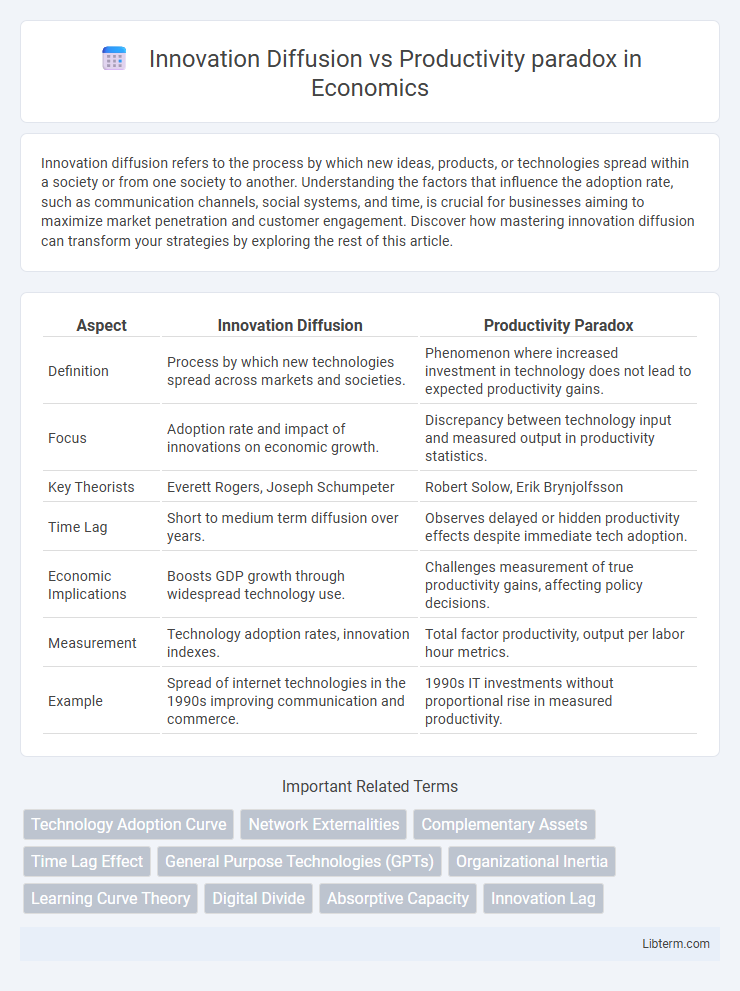Innovation diffusion refers to the process by which new ideas, products, or technologies spread within a society or from one society to another. Understanding the factors that influence the adoption rate, such as communication channels, social systems, and time, is crucial for businesses aiming to maximize market penetration and customer engagement. Discover how mastering innovation diffusion can transform your strategies by exploring the rest of this article.
Table of Comparison
| Aspect | Innovation Diffusion | Productivity Paradox |
|---|---|---|
| Definition | Process by which new technologies spread across markets and societies. | Phenomenon where increased investment in technology does not lead to expected productivity gains. |
| Focus | Adoption rate and impact of innovations on economic growth. | Discrepancy between technology input and measured output in productivity statistics. |
| Key Theorists | Everett Rogers, Joseph Schumpeter | Robert Solow, Erik Brynjolfsson |
| Time Lag | Short to medium term diffusion over years. | Observes delayed or hidden productivity effects despite immediate tech adoption. |
| Economic Implications | Boosts GDP growth through widespread technology use. | Challenges measurement of true productivity gains, affecting policy decisions. |
| Measurement | Technology adoption rates, innovation indexes. | Total factor productivity, output per labor hour metrics. |
| Example | Spread of internet technologies in the 1990s improving communication and commerce. | 1990s IT investments without proportional rise in measured productivity. |
Understanding Innovation Diffusion: Key Concepts
Innovation diffusion explains how new technologies and ideas spread across markets and societies, driven by factors like adoption rates, communication channels, and social systems. Key concepts include the S-curve model illustrating slow initial adoption, rapid growth, and eventual saturation, as well as the roles of innovators, early adopters, and laggards in the process. Understanding these mechanisms helps clarify why productivity gains from innovation may not immediately appear, addressing aspects of the productivity paradox.
The Productivity Paradox: An Overview
The Productivity Paradox highlights the discrepancy between rapid technological innovation and slower-than-expected productivity growth in organizations and economies. Scholars observe that despite significant investment in information technology, measurable gains in output and efficiency often lag, suggesting complexities in adoption, integration, and complementary factors. Understanding this paradox involves analyzing time lags, measurement challenges, and the role of organizational change in realizing productivity benefits from innovation diffusion.
Historical Perspectives: Technology Adoption and Productivity
Historical perspectives on technology adoption reveal that innovation diffusion often faces a lag before significantly impacting productivity, as seen during the early stages of the Industrial Revolution and the computer age. Despite rapid technological advancement, productivity paradoxes emerged when immediate productivity gains were overshadowed by the time required for organizational adaptation and complementary investments. This delayed correlation highlights the critical need for understanding the multifaceted process in which innovation diffusion gradually translates into tangible productivity improvements.
Factors Influencing Innovation Diffusion
Factors influencing innovation diffusion include technology complexity, user readiness, market demand, and communication channels effectiveness. Organizational culture, economic incentives, and regulatory environment also play critical roles in how quickly and widely innovations are adopted. Contrasting the productivity paradox, these factors determine the gap between innovation introduction and its measurable impact on productivity growth.
Causes and Evidence of the Productivity Paradox
The Productivity Paradox arises despite rapid technological innovations due to factors such as measurement challenges, lag effects, and organizational resistance to change. Empirical evidence highlights discrepancies between advanced IT adoption and stagnant productivity metrics, often attributed to intangible benefits and reallocation of resources. Studies reveal that productivity gains materialize slowly as firms adapt processes and human capital to harness new technologies effectively.
Measuring the Impact of Innovation on Productivity
Measuring the impact of innovation on productivity requires analyzing both direct and indirect effects, such as increased output per labor hour and enhanced process efficiencies. The Innovation Diffusion theory highlights how widespread adoption over time can amplify productivity gains, whereas the Productivity Paradox reflects challenges in capturing these benefits accurately through conventional metrics. Advanced data analytics and longitudinal studies are essential to reconcile this paradox by quantifying innovation's true contribution to economic growth.
Bridging the Gap: Resolving the Paradox
Bridging the gap between innovation diffusion and the productivity paradox requires comprehensive measurement frameworks that accurately capture intangible assets and process improvements. Enhancing data integration from diverse innovation channels and investing in workforce skill development accelerates productive utilization of new technologies. Targeted policy interventions promoting collaboration between firms and research institutions reduce lag times, transforming innovation diffusion into tangible productivity gains.
Case Studies: Innovation Uptake vs. Productivity Gains
Case studies reveal that rapid innovation uptake does not always translate into immediate productivity gains, highlighting the complexity of the productivity paradox. For instance, the introduction of information technology in the 1990s showed significant adoption rates but lagged in boosting overall productivity metrics due to learning curves and integration challenges. In contrast, sectors like manufacturing demonstrated quicker productivity improvements as innovations were closely aligned with operational processes and worker skills development.
Strategies to Accelerate Productive Innovation Diffusion
Effective strategies to accelerate productive innovation diffusion include targeted knowledge-sharing platforms that facilitate rapid dissemination of best practices and user feedback. Leveraging data analytics enables precise identification of adoption barriers, allowing tailored interventions that enhance user engagement and operational efficiency. Establishing collaborative ecosystems among firms, research institutions, and government bodies fosters trust and resource pooling, driving faster integration of innovations into productive use.
Future Outlook: Overcoming the Productivity Paradox
Emerging technologies such as artificial intelligence, automation, and advanced data analytics are poised to accelerate innovation diffusion, thereby enhancing productivity growth. To overcome the productivity paradox, organizations must invest in complementary assets like workforce training, organizational change, and infrastructure modernization. Future outlooks emphasize the integration of innovation diffusion strategies with effective implementation to realize measurable productivity improvements.
Innovation Diffusion Infographic

 libterm.com
libterm.com